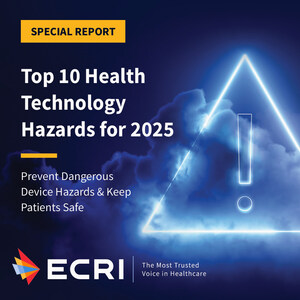ECRI's data analysis found that most errors (nearly 70 percent) occurred during the testing process – including when healthcare staff are ordering, collecting, processing, obtaining results, or communicating results. Twelve percent of errors occurred in the monitoring and follow-up phase; with nearly nine percent during the referral and consultation phase.
Of errors that occurred during testing, more than 23 percent were a result of a technical or processing error, like the misuse of testing equipment, a poorly processed specimen, or a clinician lacking the proper skill to conduct the test. Another 20 percent of testing errors were a result of mixed-up samples, mislabeled specimens, and tests performed on the wrong patient.
"It's a common misconception that if a patient has a missed or incorrect diagnosis, their doctor came up with the wrong hypothesis after having all the facts," said ECRI President and CEO Marcus Schabacker. "That does happen occasionally, but we found that was tied to less than 3 percent of diagnostic errors. What's more likely to break the diagnostic process are technical, administrative and communication-related issues. These represent system failures, where many small mistakes lead to one big mistake."
Causes of Diagnostic Error
At least 1 in 20 US adults experiences a diagnostic error each year, according to a 2017 study. Another study estimated 795,000 Americans experience permanent disability or death each year due to misdiagnosis of dangerous diseases.
Many factors can cause diagnostic errors, including miscommunication among providers; miscommunication between providers and patients; and systemic factors like productivity pressures that prevent providers from exploring all investigative options or from consulting other providers. In some of the cases ECRI analyzed, test results were not reviewed quickly enough by the provider who ordered them, or results were never communicated to the patient themselves. Referrals to specialists or requests for additional consultations can complicate the process, presenting more potential failure points.
Health Equity Crisis
Although any patient can experience diagnostic error, women and racial and ethnic minorities are at greater risk, with one study pointing to a 20 to 30 percent increase in the likelihood they are misdiagnosed. This is due to many factors, including providers' explicit or implicit biases; race-based biases in medical algorithms; barriers to care and insurance access; and communication barriers.
ECRI's PSO data only included race and ethnicity of patients in 17 percent of the incidents related to diagnostic error – pointing to a need for the industry to more comprehensively include and analyze race and ethnicity data in the analysis of diagnostic equity.
ECRI's Process
ECRI analyzed more than 3,000 patient safety adverse events and near-misses submitted to ECRI and the ISMP PSO in 2023 by healthcare providers around the US. The events were analyzed using a combination of querying free-text fields and natural language processing data, followed by manual validation. Of the 3,014 patient safety events, 1,011 were determined to be related to diagnostic errors, then sorted into the appropriate step in the diagnostic process where the breakdown occurred.
Patient Stories
ECRI's report includes de-identified examples of cases when diagnostic error impacted patient care. A woman experienced abdominal pain and abnormal vaginal bleeding for months. It took nearly a year for her to be diagnosed with metastatic uterine cancer, after numerous doctor visits and tests. MRIs were ordered, but not all the results were reviewed, as her symptoms worsened. Despite masses being detected on an ultrasound, a missed appointment and communication barriers delayed her diagnosis. She was finally diagnosed after severe pain led to hospitalization.
The study also analyzed what's known as "near misses," incidents when healthcare staff caught an oversight or error before it caused harm. In one such case, a patient who was scheduled for open-heart surgery had their procedure rightfully canceled after staff noticed a critical test hadn't been performed: a carotid ultrasound. The ultrasound, ordered just in time, revealed he would have had a catastrophic surgical outcome if the surgery had proceeded as scheduled.
Advice for Patients
Although most of the diagnostic process is out of the patients' control, Schabacker shared tips for patients seeking to improve the likelihood they get a prompt and accurate diagnosis.
"It is important patients ask questions to understand why their doctor is ordering tests, and are those tests urgent," said Schabacker. "Schedule your appointments and tests quickly and follow up with your provider if you're awaiting results. If possible, ask a family member or friend to join you in important appointments, to help ask questions and take notes."
Best Practices for Healthcare Leaders
ECRI's report identifies strategies healthcare organizations can execute to improve diagnostic safety, centered on the total systems safety approach and human-factors engineering.
"The problem of diagnostic safety comes down to the lack of a systems-based approach. Since there are multiple potential failure points, a single intervention is insufficient," warned Schabacker.
Integrating EHR workflows, optimizing testing processes, tracking results, and establishing multidisciplinary diagnostic management teams to analyze safety events are listed as essential components of a diagnostic safety program. Staff should be encouraged to report errors and "near-misses" across all phases of the process to prevent what Schabacker calls a "common and destructive blame and shame culture" in some healthcare environments.
World Patient Safety Day
The new diagnostic safety data comes just weeks before World Patient Safety Day on September 17, 2024, celebrated by the World Health Organization and healthcare leaders around the globe to raise awareness on patient safety issues. This year's theme is "Improving diagnosis for patient safety."
About ECRI
ECRI is an independent, nonprofit organization improving the safety, quality, and cost-effectiveness of care across all healthcare settings. With a focus on technology evaluation and safety, ECRI is trusted by healthcare leaders and agencies worldwide. ECRI is designated an Evidence-based Practice Center by the U.S. Agency for Healthcare Research and Quality. ECRI and the Institute for Safe Medication Practices PSO is a federally certified Patient Safety Organization as designated by the U.S. Department of Health and Human Services.
SOURCE ECRI








Share this article